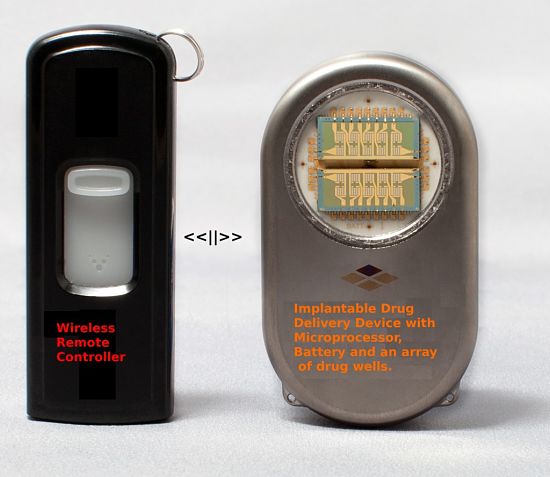Wirelessly Controlled Implanted Drug Delivery Devices Offer Superior Treatment
The concept that microprocessor controlled devices could be implanted under a patient's skin to control, manage and monitor the release of drugs has taken another step forward with the completion of various human trials. The programmable nature of the latest devices, and the two-way wireless communication, provide a wonderful suite of benefits for doctors and patients for the treatment of various diseases.
There is a huge array of applications for these devices to treat aliments such as multiple sclerosis, various cancer treatments, pain management and the delivery of vaccines and chemotherapy agents. Applications of these devices have been made for dentistry, anti-coagulation, immunization, narcotic antagonists, and insulin delivery. The implanted therapeutic systems are mainly used for continuous drug administration or for long-term, precisely controlled, administration of drugs.
This article described how these new devices work and their potential applications in medicine.

Recent Trials of Implanted Drug Delivery Devices
In a recent trial in humans, the new devices were implanted in a number of women to treat osteoporosis. The device was tested on 7 Danish women, aged between 65 and 70.
This study is the first trial of drug delivery microprocessor controlled devices implanted in humans that can be remotely managed and monitored. The devices have previously been widely tested in animals.
The microprocessor chip devices were inserted under the skin near the patient's waist and activated by remote control to deliver set doses of a drug to treat osteoporosis. The drug in the trial would normally have to be administered by daily injections at a medical center. The devices were programmed using wireless remote connections to release the daily doses. The device provided feed-back signals to confirm that the drug had been released properly into the patient's circulation.
Tests showed that the daily releases of the drug by the device increased bone formation in the patients and were very successful. No adverse effects occurred during the trail, and there were no signs of toxicity or side-effects due to the device or the drug release. The patients were very pleased with the implants, which had much less impact on their daily lives than daily injections.
Monitoring tests during the trail, showed that the chips administered the correct doses at the right times, and that there were no malfunctions or side-effects.
Other Uses for Implanted Drug Delivery Devices
It is also possible that these devices could monitor various parameters in the body and deliver drug doses on demand.
The technology used in the devices has been under development for more than 15 years and has been extensively tested in animals.
The full device package is about the size of a heart pacemaker (about 5 cm x 3 cm, and 1 cm thick). It is made with biologically compatible coatings on the exterior. This prevented any inflammation or other adverse reaction when the device was implanted.
The fingernail-sized computer chip is connected to a set of tiny, individually sealed reservoirs, for delivering measured dosages of a drug. The drug wells are covered by a thin membrane of titanium and platinum. A tiny electrical current us used to perforate the membrane releasing the drug. The electric current caused the special membrane to decompose in about 25 microseconds. The drug released into the tissues was then picked by the blood surrounding the device and entered the bloodstream.
The development team is attempting to scale up the system so that it can include a lot more than the 20 doses in 20 wells used in the trial. The developers believe that these implanted drug delivery devices could be made with hundreds of wells for drugs of various types. These more highly developed devices, with much higher capacities, should be ready for use in 3-10 years.
The devices offer a fabulous improvement for patients who otherwise have to inject themselves with drugs. They are much more convenient and potentially much more reliable modes of treatment for patients needing regular medication.
Advantages of Implanted Drug Delivery Systems
- Improved patient compliance.
- Easy to manufacture and relatively inexpensive.
- Allows administration of drugs having short in-vivo half-lives.
- The method is relatively inexpensive and less wasteful of the drug.
- Readily retrievable by medical personnel to replenish the drug "wells" or terminate medication.
- Drugs are released in a rate-controlled manner, which is more effective and has less side-effects.
- Improved efficiency of treatment with reduced side effects and maximum efficiency for the patient.
- Continuously supplying small amounts of drug may be less painful and more effective than several large doses.
- Improved drug administration and treatment in underprivileged areas where adequate medical supervision is not available.
- Improve patient compliance by reducing the frequency of drug administration at medical centers over the entire period of treatment.
- The devices reduce infections and other problems from daily injections. The devices are bio-compatible, environmentally stable, and sterile.
- The frequency of drug administration can be variety using the wireless control. Drug release can be linked with monitoring of signals in the patient, eventually in an automatic way.
Disadvantages of the Implanted Drug Delivery Systems
- Possible pain and inconvenience.
- Possible toxicity and allergic reaction to the device.
- Expense of the devices that may need to be replaced regularly.
- Possible control issues through chip malfunctions and other breakdowns.
- Need for microsurgery to implant the system and regularly replacements may be required over a long period of time. The number of doses may be limited to 20-200 depending on the drug.